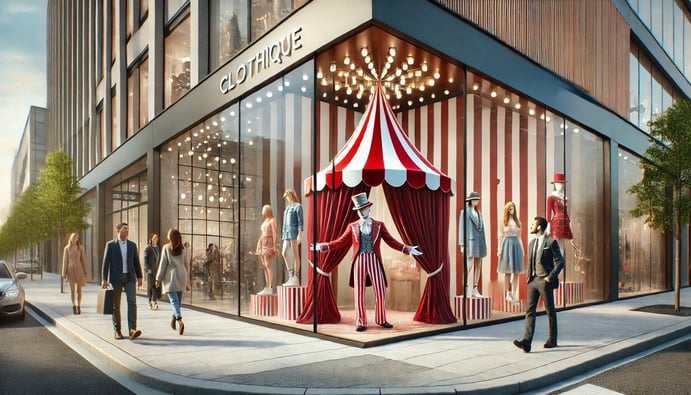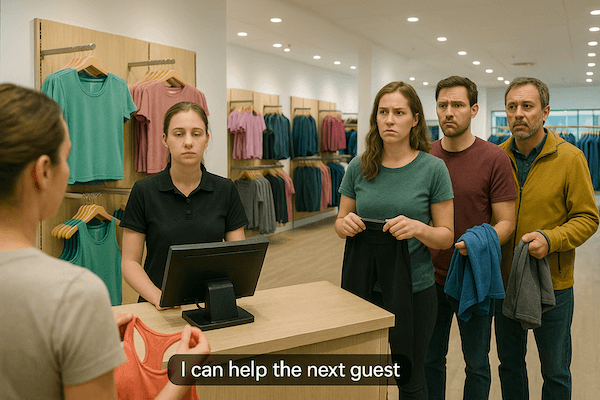"Welcome In” Isn’t a Greeting: It’s a Sales Killer

Subscribe to our newsletter
You've heard it walking through stores: "Welcome in." A phrase that sounds meaningful but isn't. It's retail's equivalent of a shrug - forgettable and damaging to customer experience.
I first noticed it in Manhattan during store tours on Madison Avenue when an associate muttered it without looking up. It stuck with me not because it was warm, but because it was meaningless. Joe Pinsker cited me as a source in his Wall Street Journal article on the subject. then ShaneO'Neill included many of my comments in this Washington Post article.
The Real Problem With "Welcome In"
"Welcome in" is retail's participation trophy of greetings - bland, impersonal, and lazy. It's what untrained employees say when they don't know what to do. It belongs in a restaurant where a host guides you to a table, not in a store where customers haven't made a purchase decision.
Yet somehow, it's become standard in everything from boutiques to chains like Gap and Abercrombie.
For years, associates have been left without training or clear expectations, so they default to what's easiest. "Welcome in" sounds friendly, requires no reply, and avoids rejection risk. That's why it caught on.
But it avoids connection. And that's the problem.
The sale starts at the greeting.
It's Not Just the Words: It's What They Replace
Let’s be clear: “welcome in” didn’t replace a great greeting. It replaced a vacuum.
For years, associates have been left to their own devices. With no formal training and no clear expectations, they default to what's easiest. “Welcome in” sounds friendly, doesn’t require a reply, and avoids the risk of rejection. That’s why it caught on.
But it also avoids connection. And that’s the problem.
The sale starts at the greeting.
Effective Greetings Signal One Thing: "You Matter"
When you look customers in the eyes and say, "Good morning," you're signaling that you see them. That they matter. When people feel they matter, they buy. When they don't, they leave.
"Welcome in" creates none of this. It's impersonal and untargeted - the kind of phrase you could replace with a motion sensor. That's not what builds loyalty or sales.
Genuine Greetings Create Connections
You say “welcome in” to someone who’s already bought a ticket. You say it to a group of tourists coming off a bus. You say it to a crowd you’re ushering into an auditorium.
You don’t say it to a potential customer standing three feet away, deciding whether they trust you enough to drop $200 on a blouse.
This is the moment of truth, and we’re letting it slip past because we’ve normalized non-engagement. We’ve taught associates that acknowledging someone’s presence is enough. But presence doesn’t convert. Connection does.
Retail Has Never Looked Better: But It's Acting Worse
Here's what's frustrating: stores today look fantastic. The merchandising, lighting, and signage represent a significant investment. The spend on design is real.
Yet the human experience is crumbling.
We've invested in aesthetics and neglected training. Stores pour money into visuals but nothing into teaching employees how to look someone in the eye and say, "Hi there, what brings you in today?"
Meanwhile, online retailers optimize every click with AI and conversion metrics. In physical stores? Employees look at phones, mumble "welcome in," and hope customers self-serve to checkout. No wonder conversion rates struggle to break 20%.
The Three Moments of Customer Intention
Consider this sequence:
- Last night, a customer watching TV thought, "I should get new boots."
- This morning, they got dressed and traveled to your store.
- They walked through your door.
That's three separate moments of intention - three signals that say, "I might want to buy from you."
And then what happens? An associate mutters "welcome in" without looking up. Or worse, says nothing.
We don't have a traffic problem. We have an engagement problem.
Want to know how to greet a shopper the right way? Discover SalesRX
Other Phrases That Kill Sales

"Welcome in" is just the start. Other phrases sabotage customer relationships just as effectively:
-
“I gotcha.” Casual to the point of dismissive.
-
“No problem.” Implies that helping you could have been a problem.
-
“Next guest.” Feels like a bus station announcement, not a personal invitation.
Each one distances your associate from the customer, even if unintentionally.
Brick-and-mortar retail doesn't die from disruption. It dies from indifference. Words matter.
This Is About Behavior: Not Blame
I'm not bashing associates. Most haven't been trained properly. They've grown up where typing feels safer than talking, where interactions happen through screens. Asking them to look someone in the eye and start a conversation is a skill, not a given.
Without that skill, "welcome in" feels safe. No risk. No expected reply. No rejection. Just a placeholder.
And yet, many retailers hold associates responsible for low conversion rates. That's precisely why training matters.
How Do You Fix It? Three Steps
-
Train actual greetings
Start with simple, direct openers: "Good morning," and a genuine compliment like "Love that patch on your jacket, did you find it or make it?" These create the foundation for rapport. -
Model and reinforce the behavior
If management doesn't demonstrate proper greetings, staff won't either. Acknowledge the awkwardness, but make it clear that genuine customer engagement isn't optional. Celebrate successful connections. -
Raise your standards
“Welcome in” isn't neutral - it's costing you sales. Track greeting effectiveness against conversion rates. Our clients using SalesRX online training report 83% achieving double-digit growth within six months because we train for behavior, not compliance.
Want Proof?
We have clients using our online training platform, SalesRX, and 83% of them report double-digit growth in six months. Why? Because we don’t train for compliance, we train for behavior. We teach teams how to sell by connecting.
It works. But only if you commit to doing it every day.
The Stakes Are High
AI improves daily. E-commerce gets faster. If your store can't offer superior human experience, it has no edge.
And you won't create that edge with "welcome in."
People don't buy from stores. They buy from people who make them feel they matter.
Next time you hear "welcome in" on your sales floor, ask yourself: Is that the voice of someone trying to sell, or someone trying not to talk?
If it's the latter, you don't have a greeting problem. You have a culture problem.
Fix it at the front door. Your store's future depends on it.



